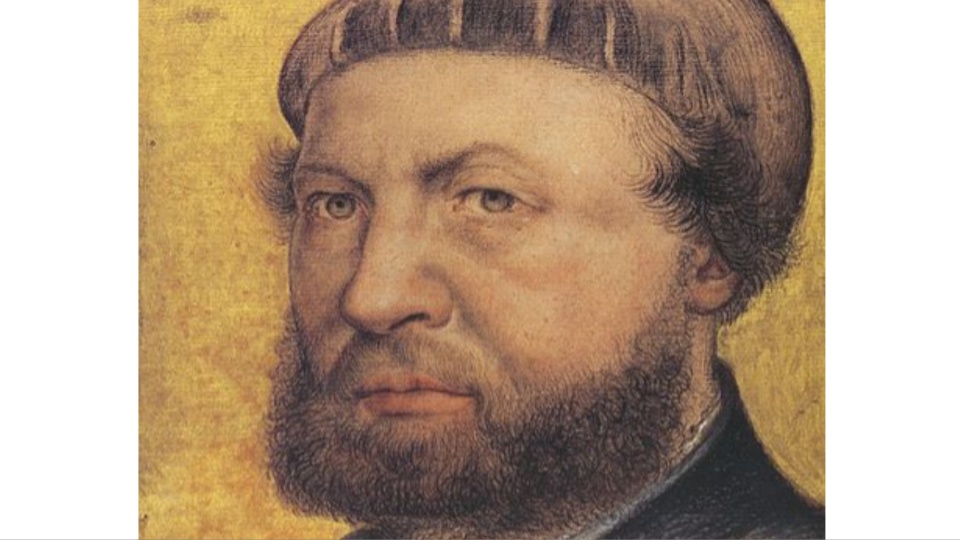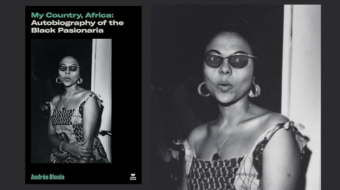
Hans Holbein the Younger, born in Augsburg in the winter of 1497/98 and died 480 years ago in October or November 1543, was one of the most important German painters of Renaissance humanism. He grew up in the free imperial city of Augsburg, a northern gateway to the Italian Renaissance, and learned the painter’s craft in his father’s workshop.
It was a golden age of art—Leonardo, Michelangelo, Titian, Raphael, Riemenschneider, Cranach, Grünewald, Dürer, Paracelsus and Hans Sachs were all contemporaries, as were Erasmus, Thomas More, Machiavelli and Henry VIII. Holbein became personally acquainted with some of these personalities, and painted portraits of a few of them.
As a young man, Holbein lived through the time that led to the Reformation and the Peasant War; Vasco da Gama discovered the sea route to the East Indies via South Africa; Magellan’s circumnavigation of the globe provided definitive proof that the Earth is round; Spain bloodily destroyed the Aztec Empire in Mexico, and Switzerland broke away from the German Empire. The New Testament was published in Luther’s translation and the chapbook Till Eulenspiegel was printed in Strasbourg.

Augsburg was the seat of the Fugger family, trading magnates and bankers who amassed enormous wealth. The Fuggers held a near-monopoly on the European copper market. Jakob Fugger “the Rich” was elevated into the nobility of the Holy Roman Empire in 1511 and is still considered one of the richest people who ever lived.
In 1514/15 Holbein migrated to Basel with his brother Ambrosius, joined a renowned workshop, and settled there. Basel was a flourishing city of book printers. During this period of revolutionary change in book design, Holbein created illustrations for the leading Basel publisher Johann Froben, the editor of Erasmus of Rotterdam’s writings. As early as 1516, Holbein produced marginal drawings for Erasmus’ In Praise of Folly, a sharp critique of scholasticism. In the same year, More’s seminal work Utopia was published, which Holbein also illustrated. In 1517, Luther initiated the Reformation. The first building of the German Renaissance, the Fugger Chapel, was erected in Augsburg.
In 1519 Holbein married Elsbeth Binsenstock, widow of a Basel tanner, which allowed him to become a citizen of Basel and a member of the city’s painters’ guild. He created portraits, religious paintings and book illustrations. In 1523 Holbein painted his first portraits of Erasmus, then a resident of Basel, who needed these illustrations for his friends and admirers throughout Europe. These works made Holbein internationally known.

In the early 1520s, Huldrych (also spelled Ulrich) Zwingli initiated the Reformation in Switzerland. In 1524, Holbein began working on the The Dance of Death images and fundamentally redesigned an old theme in 40 variations. During this time, the Peasant War broke out, led by Florian Geyer in Franconia, Thomas Müntzer in Thuringia, and Michael Gaismair in Tyrol. Luther betrayed the peasants (Against the Murderous, Thieving Hordes of Peasants), and the peasants, demanding relief from their servitude in twelve articles, were devastatingly defeated by the princes at Frankenhausen, strengthening the nobility’s power.
In 1526, through Erasmus’ mediation, Holbein traveled to England and spent nearly two years in the home of Thomas More and his humanist circles, where he gained a reputation. Numerous portraits of English personalities of the time were created, including More himself and the Archbishop of Canterbury.
At the same time, Dürer sided with the revolutionary peasants and embraced the Reformation. Paracelsus burned books of scholastic medicine at the University of Basel and proclaimed his new curriculum. In 1528, Holbein returned to a turbulent Basel, engulfed by the Reformation, where many old patricians left the city, churches were left to the Protestants, and there was a fierce wave of iconoclasm. In 1528, as one of the first representations of an artist’s own household, Holbein painted The Artist’s Family. In 1529, Erasmus moved from Basel to Freiburg. In 1532, Holbein left Basel for good and settled in London, where in 1536, he became the court painter to Henry VIII and passed away in 1543 at the age of 45.

Holbein’s early work shows a strong anti-Roman tendency. Like other humanists in Basel, he felt ambivalent toward the Reformation. While they desired church reform, they hesitated to fully break away from the traditional faith because they feared the Reformation could promote popular opposition. However, until the Peasant War, Holbein can be seen as supportive of the reformist movement. He created woodcuts that denounced the papacy and the sale of indulgences, and depicted fighting peasants. Most notably, his cycle The Dance of Death, created during the Peasant War, contains profoundly anti-clerical and democratic statements. The Dance of Death genre of images had been passed down since the 14th century, but Holbein infused his depictions with the spirit of the Reformation. His drawings designed for woodcuts were executed by Hans Lützelburger.
It is striking how many clergy, from pope to nun, and secular authorities, from emperor to judge to merchant, are claimed by Death here. They are typically portrayed as well-fed and indifferent to the suffering of the people. The impoverished common people are visited by Death while working. The Duke is captured by Death at the moment he rejects a starving woman with her child; the Senator, paying no attention to the beggar, has the devil of pride sitting on his shoulder. The Judge is bribed by the rich, while a poor man stands helplessly at the edge of the image; the judge’s staff is in the hand of Death. The Lawyer too is bribed by a wealthy citizen, while the poor man watches powerlessly with his hat in hand. The Rich Man, with the features of Jakob Fugger, sits over his treasures in the cellar with heavily barred windows, where Death finds him.

On another sheet, the Merchant’s splendid trading ships lie in the harbor, their flags flying in the wind, favoring trade. Goods from all over the world are unloaded, securely packed, soon to be turned into profit. But here too, Death pulls at the merchant’s coat while he vainly clings to the packaging ropes. Death takes the Nun in her cell in front of the altar as she looks around at her lover, seated on her bed. Did this young woman enter the convent voluntarily? In the image The Young Child, a woman with children in a miserable hut prepares soup over an open fire: Death takes her youngest.

The Ploughman, barefoot and ragged behind the plough, is too weak to dig deep furrows. Death drives the horses, and the peasant works until his end. For him, a peaceful, sunny landscape with a village on the horizon appears, quite unlike any seen in the other sheets of The Dance of Death. At this time, landscape painting was gaining new significance with the work of Albrecht Altdorfer. In Holbein’s painting, paradise is perhaps joined with Thomas More’s earthly utopia, the island where there is no place for the wealthy, and private property is abolished.
The expressive, realistic style of Holbein’s early work reflects the spirit of the early bourgeois revolution. His portraits also demonstrate tremendous characterization. Holbein painted his models in a cool and objective manner, emphasizing the essence of the depicted person. Significant examples include the portraits of Erasmus and The Artist’s Family.
In his final years in London as a court painter, Holbein became a celebrated artist who portrayed the rich and powerful, designed decorations for court festivities, and created jewelry, plates, and other valuable objects. His paintings of the royal family and the nobility testify to the royal court during the time when Henry VIII solidified his control over the Church of England, separating it from the Roman Church and the papacy. The political and religious climate in England had drastically changed. In 1532, Henry VIII challenged the authority of the Pope when he annulled his marriage to Catherine of Aragon to marry Anne Boleyn. More opposed this move and resigned from his office as Lord Chancellor (supreme judge and adviser to the monarch) in May 1532. In 1535, More was beheaded. To Erasmus’ great disappointment, Holbein distanced himself from More’s humanist circles and found patrons among the new power circles.
We hope you appreciated this article. At People’s World, we believe news and information should be free and accessible to all, but we need your help. Our journalism is free of corporate influence and paywalls because we are totally reader-supported. Only you, our readers and supporters, make this possible. If you enjoy reading People’s World and the stories we bring you, please support our work by donating or becoming a monthly sustainer today. Thank you!










